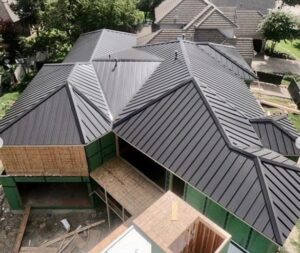Steep-slope Products
Steep-slope roofing, which is also known as residential roofing, makes up a large portion of work in the roofing industry.
When you have a roof leak or need roof maintenance, the first step is to find a roofer you feel confident in. After you find a roofing contractor you want to work with, it's time to make some decisions about the roofing products and materials you want to use on the project. Many people get overwhelmed by the number of options presented to them, which is why we have created this roofing resource at AskARoofer. Keep reading to get some basic roofing information!
Asphalt
Composition shingles are one of the most used roofing products and are also known as asphalt shingles, fiberglass shingles, laminate shingles, dimensional shingles or architectural shingles. Originally these shingles were made from layers of paper that were saturated with asphalt to make them waterproof, then granules were embedded into the shingle to give it color and protection from the sun. These were called organic shingles and would tear easily, lasting barely twenty years. They are also known as three tab shingles because of the cutouts in the shingle that gave it three separate tabs.
Then fiberglass-reinforced shingles were introduced into the market. This shingle starts with a fiberglass mat that is coated with asphalt and then embedded with ceramic granules. These shingles are stronger, resist tears, and have a longer life span. The 3 tab design is still available but the asphalt shingle has mutated to a laminated type shingle. Asphalt shingles are the most commonly used shingles because of their walkability, looks, cost, and life span. The asphalt shingle has many designs.
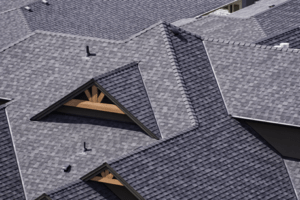
Cedar shake or shingle
Cedar shakes and shingles are and have been one of the most popular types of roofing because of their durability. Not as many people feel as comfortable with them regarding fire and life span. Permanently fire retardant genuine cedar shakes with class A, B or C ratings are available and still are being installed. These high-quality cedar shakes after being milled are placed in pressure treatment cylinders where fire retardants are injected into the inner cells of the wood. The material then goes through a polymerization process that locks in the fire retardants into the wood fibers. The shakes then are tested and certified by Underwriters Laboratories and the National Fire Protection Association.
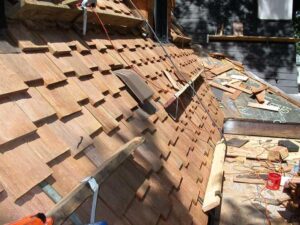
Clay tile
Clay has been used for roof tiles since 10,000 B.C., which is when the first recorded tile roof was identified in China. The Middle East followed suit shortly after. Clay is a versatile material and can easily be curved or tapered. Tile roofs give homes a unique and Old-World look. Coming in a variety of colors and shapes, these roofs are durable, reflect sunlight and are fire resistant. There are four main styles of clay tiles:
- Mission – This type of tile is known as the original barrel-style shingle. Mission tiles alternate between concave pans and convex covers. Commonly found in Italian, French and Spanish architecture, this style is also very popular in the Southwestern U.S.
- Spanish – Sometimes referred to as S tiles because of their shape, these tiles are less labor-intensive to install due to their one-piece design. They create a ripple effect on the roof and have a barrel shape.
- French – These have two flutes per tile, offering excellent drainage and a nice textured aesthetic.
- Flat – Flat tiles are applied similarly to how wood shakes are installed. These tiles can be interlocked like puzzle pieces with a channel on one side and a lip on the other, or they can overlap, creating a multidimensional pattern.
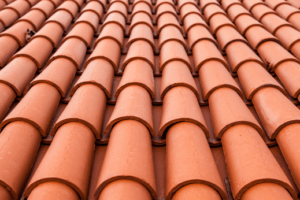
Composite roofing
Made to look like real slate, shake or Spanish tiles, synthetic roofing can be made from either recycled materials or virgin resins, like polyethylene. Because they are manufactured, simulated roofing tiles are generally made to resist impact, fire, insects, cracking and splitting. They can stand up to high winds, hailstorms, and strong UV rays. These are advantages of man-made roofing.
Some manufacturers use molds made from actual shake and slate, so the final simulated roofing is very authentic-looking --- like rough-hewn, hand-split cedar or natural slate. There are a wide range of colors and color blends available in composite roofing materials that replicate nature. Oftentimes manufacturers can create custom colors to complement a specific project.
Other good news about synthetic roofing is that warranties are generally very strong. The products are long-lasting (with some manufacturers offering lifetime limited warranties) and pieces can oftentimes be recycled.

Concrete tile
Concrete tiles are a popular alternative to clay tiles because they are lighter weight and less expensive. These durable tiles have a lifespan of approximately 50 years and require low maintenance. Resistant to fire, rot and insects, concrete roof tiles are made of a combination of sand, cement and water. These tiles are available in several different colors and can have a smooth or rough surface texture. There are three different profiles available: flat profile with no curves, low profile with small curves, and high profile with large curves.

Metal standing seam roof panels
Metal standing seam roofs are not only durable, but they also look great. The roof is made up of preformed metal panels that are locked together from one end of the roof to the other. These panels come in a variety of colors. This type of roof is excellent in higher elevations to allow snow to slide off easily. Here are additional great benefits of metal roofing:
50- to 60-year life span - When installed properly, a metal roof can last 50 years or longer, where asphalt roofing, on the other hand, typically needs to be replaced every 15 to 20 years. So, even though a metal roof will cost more than asphalt shingles initially, you will actually save money in the long run. It is also important to note that many metal roofing products are offered with lifetime warranties of 30- to 50-plus years.
Low maintenance - Metal is the most low-maintenance roofing material on the market today. It can save homeowners loads of money on upkeep over the years. In fact, in most applications, a metal roof will require no ongoing maintenance for the entire life of the roof. Gone are the days of shingles buckling, cracking or developing unsightly discoloration. Since the life of a metal roof is upwards of 50 years and the average asphalt shingle roof only lasts about 15 to 20 years, the homeowner can expect to save more than 60 percent in total roofing costs over the life of the roof. Considering the additional potential roofing life cycle savings in energy costs, insurance, resale and taxes, your client can be confident that a metal roof will be a sound investment for their home and family.
Weatherproofing - Metal is one of the most durable, weather-resistant roofing materials available. Homeowners often opt for metal roofs because they last longer or can achieve a certain look, but many don’t know that they also protect against UV rays, mildew, fire, wind and hail and are much more impact-resistant compared to other roofing materials. In areas with extreme heat or cold, high winds, or humidity, the long-lasting advantages of weatherproof metal roofing can be even greater.
Energy efficiency - Studies conducted by the Cool Metal Roofing Coalition and the Oak Ridge National Laboratory show that energy-efficient metal roofing materials coated with Energy Star-certified high reflectance paint systems can save homeowners up to 40 percent on cooling costs compared to asphalt shingles. A typical shingle roof absorbs most of the sun’s energy, making the attic extremely hot in the warmer months. On the contrary, Energy Star-certified metal roofs reflect a high percentage of the sun’s energy back into the atmosphere, which lowers attic temperatures and makes the roof more energy-efficient. In order to meet Energy Star criteria for roofing, the metal roof needs to have a total solar energy reflectance of at least 25 percent. Lighter metal roof colors have better reflectivity. For example, the reflectivity of a white metal roof exceeds 60 percent.
Increased home value - Metal roofs come in an array of colors, designs and finishes, so even the most discerning homeowner can find an option that suits them well. From contemporary to traditional, old-fashioned to futuristic, there is a metal roof out there that will bring out the best in any home. If interested in increasing the resale value of a home, re-roofing with metal has proven to provide a better return on investment than simply replacing asphalt shingles. Depending on the area, a metal roof will typically add 1 to 6 percent to the home’s resale value, with the highest gains in states along the East Coast.
Slate
A slate roof is one of the most interesting roofs to look at. With a little maintenance and correct installation, it can last 60-150 years or more, which outlasts most traditional roofing materials. It is such a visual roof considering the wide variety of natural slate colors available, which offers limitless opportunities for homeowners to create truly unique roofs that are not only beautiful, but durable and strong.
The basic reason these roofs last so long is that slate is a tough, durable stone, quarried from places all over the world. A microcrystalline metamorphic rock, or slate as we commonly call it, is made from the sediments and silts that settled on the seafloor over 400 million years ago. Due to specific weather and temperature conditions of the ocean water over time as it turned into modern land, the sediments were molded and became the slate beds where modern miners find the material we use today in roofing, flooring and countertops.
The shale quarries where the slate is harvested were formed many thousands of years ago from layers of fine clay and silt sediment. This sediment is compressed under high pressure for thousands of years, making it a very dense mudstone. This squeezing of the geological crystals causes natural parallel cleavage planes. Having these cleavage planes make the stone split very easily, almost like a cedar shake would split. Slate is perfect for making all kinds of slate roof tiles.
Colors are native to the country ground of the quarry, with flashes of different minerals present in the ground, it can give the slates a variety of colors and blends or be the same color. The color of a natural slate is derived from its chemical and mineral composition. Chlorite produces green slate, hematite the purples, carbon the grays and blacks, and hematite and iron oxide the reds.
Natural slate roofing provide many unique and aesthetic advantages. Some of these include the subtle variation in color, shade, veining and grain of each individual slate shingle. Additionally, there are many sizes of slates, from thickness to width and length.
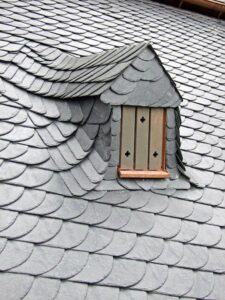
Stone coated steel
Most stone coated roofing is made from aluminum-zinc alloy coated steel. It is architecturally designed to look like the heavier concrete tile roofs but weighs only 1.6 pounds per square foot. The coating is a stone chip finish that is acrylic bonded to the steel surface. The stone coating is what protects the product from the sun's UV rays and resists fading. It has durability and beauty for a longer life cycle than cedar. These shakes are virtually maintenance-free and have a sustainable advantage of 50 years.





